weight CHEVROLET LUMINA 1993 1.G Owners Manual
[x] Cancel search | Manufacturer: CHEVROLET, Model Year: 1993, Model line: LUMINA, Model: CHEVROLET LUMINA 1993 1.GPages: 324, PDF Size: 17.44 MB
Page 125 of 324
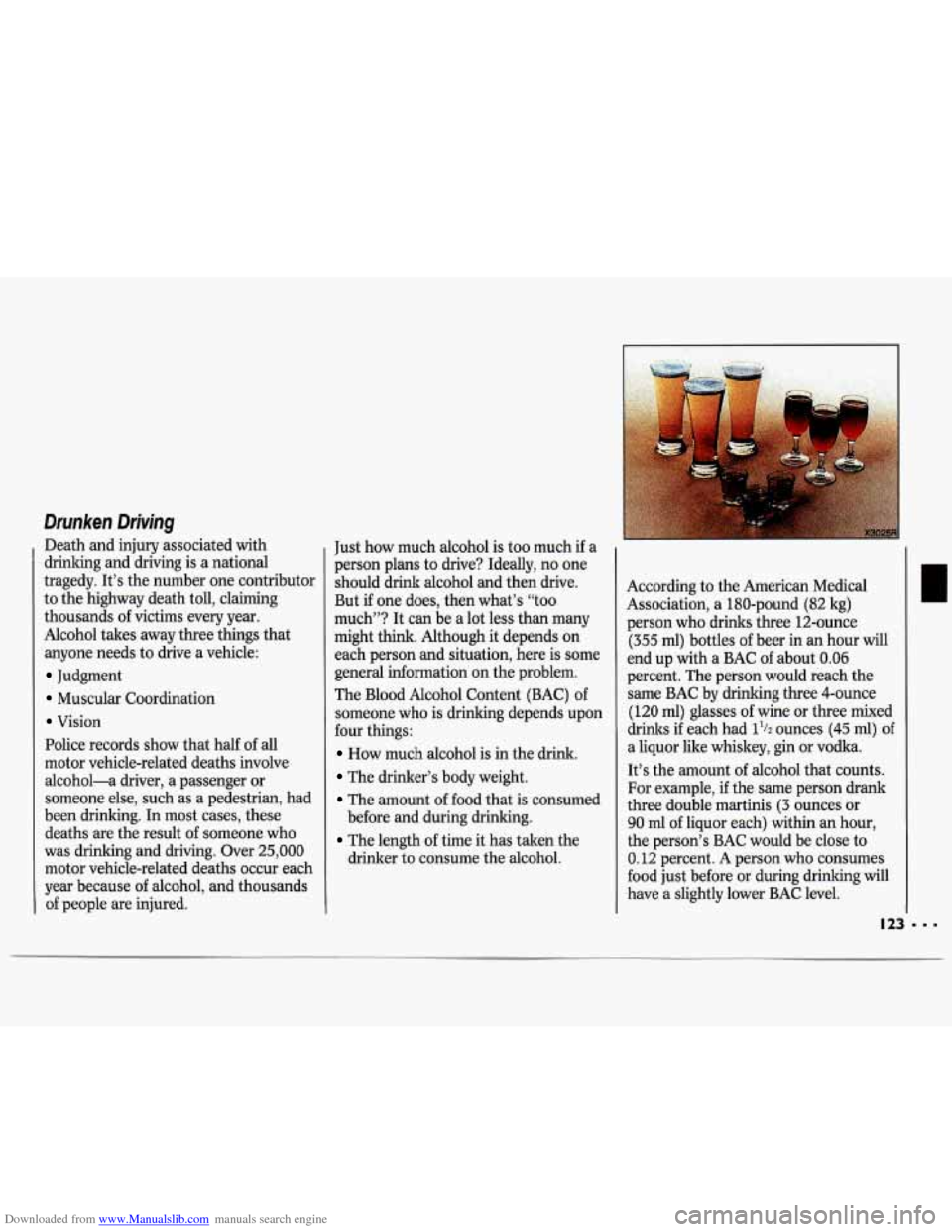
Downloaded from www.Manualslib.com manuals search engine Drunken Driving
Death and injury associated with
drinlung and driving is
a national
tragedy. It’s the number one contributor
to the highway death toll, claiming
thousands of victims every year.
Alcohol takes away three things that
anyone needs to drive a vehicle:
Judgment
Muscular Coordination
Vision
Police records show that half
of all
motor vehicle-related deaths involve
alcohol-. driver, a passenger or
someone else, such as a pedestrian, had
been drinking. In most cases, these
deaths are the result of someone who
was drinking and driving. Over
25,000
motor vehicle-related deaths occur each
year because
of alcohol, and thousands
of people are injured. person plans
to drive? Ideally, no one
should drink alcohol and then drive.
But
if one does, then what’s “too
much”? It can be a lot less than many
might think. Although it depends on
each person and situation, here is some
general information on the problem.
The Blood Alcohol Content (BAC) of
someone who is drinking depends upon
four things:
How much alcohol is in the drink.
The drinker’s body weight.
The amount of food that is consumed
before and during drinking.
The length of time it has talcen the
drinker to consume the alcohol. According
to the American Medical
Association, a 180-pound
(82 kg)
person who drinks three 12-ounce
(355 ml) bottles of beer in an hour will
end up with a BAC of about 0.06
percent. The person would reach the
same BAC by drinking three 4-ounce
(120
ml) glasses of wine or three mixed
drinks
if each had 11/2 ounces (45 ml) of
a liquor like whiskey, gin or vodka.
It’s the amount
of alcohol that counts.
For example, if the same person drank
three double martinis
(3 ounces or
90 ml of liquor each) within an hour,
the person’s BAC would be close to
0.12 percent. A person who consumes
food just before or during drinlung will
have a slightly lower BAC level.
Page 153 of 324
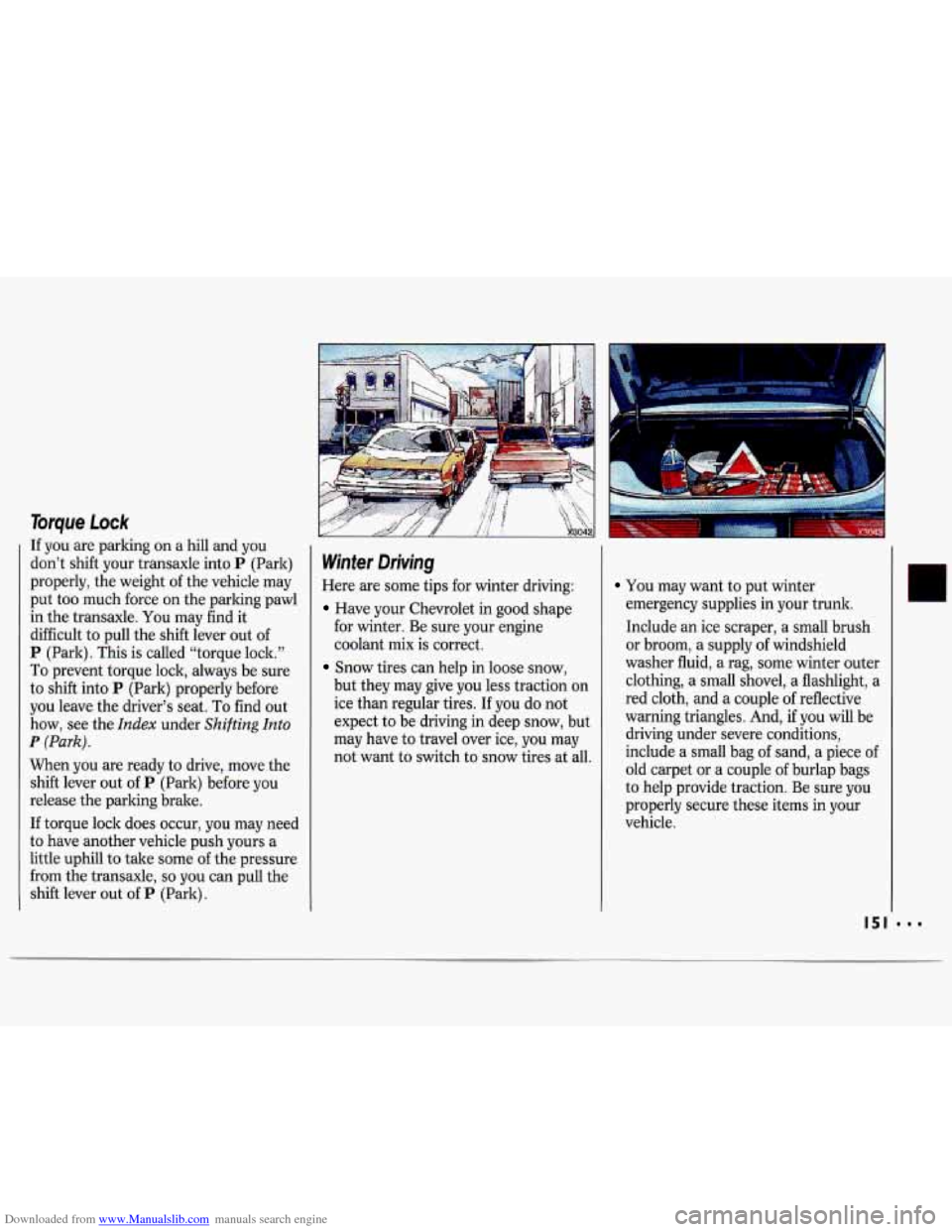
Downloaded from www.Manualslib.com manuals search engine Torque Lock
If you are parking on a hill and you
don’t shift your transaxle into
P (Park)
properly, the weight of the vehicle may
put too much force on the parking pawl
in the transaxle. You may find it
difficult
to pull the shift lever out of
P (Park). This is called “torque lock.”
To prevent torque lock, always be sure
to shift into
P (Park) properly before
you leave the driver’s seat. To find out
how, see the
Index under Shifting Into
P (Park).
When you are ready to drive, move the
shift lever out of
P (Park) before you
release the parking brake.
If torque lock does occur, you may need
to have another vehicle push yours a
little uphill to take some
of the pressure
from the transaxle, so you can pull the
shift lever out of
P (Park).
Winter Driving
Here are some tips for winter driving:
Have your Chevrolet in good shape
for winter. Be sure your engine
coolant mix
is correct.
Snow tires can help in loose snow,
but they may give you less traction on
ice than regular tires.
If you do not
expect to be driving in deep snow, but
may have to travel over ice, you may
not want to switch to snow tires at all.
You may want to put winter
emergency supplies in your trunk.
Include an ice scraper, a small brush
or broom, a supply of windshield
washer fluid, a rag, some winter outer
clothing, a small shovel, a flashlight,
a
red cloth, and a couple of reflective
warning triangles. And, if you will
be
driving under severe conditions,
include a small bag of sand, a piece
of
old carpet or a couple of burlap bags
to help provide traction. Be sure you
properly secure these items in your
vehicle.
151
Page 157 of 324
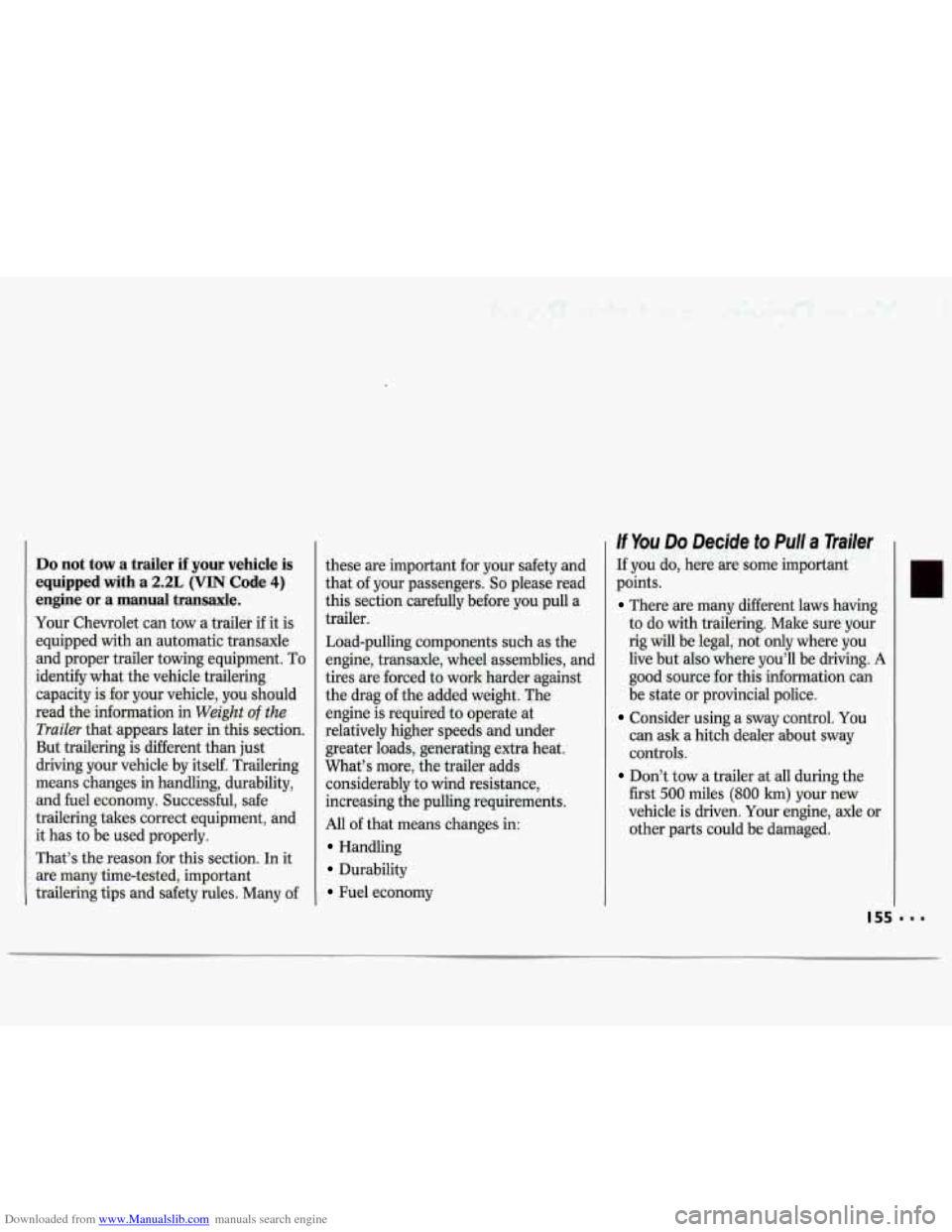
Downloaded from www.Manualslib.com manuals search engine Do not tow a trailer if your vehicle is
equipped with a 2.2L (VIN Code 4)
engine or a manual transaxle.
Your Chevrolet can tow a trailer if it is
equipped with an automatic transaxle
and proper trailer towing equipment. To
identify what the vehicle trailering
capacity is for your vehicle, you should
read the information in
Weight of the
Trailer
that appears later in this section.
But trailering is different than just
driving your vehicle by itself. Trailering
means changes
in handling, durability,
and fuel economy. Successful, safe
trailering takes correct equipment, and
it has to be used properly.
That’s the reason for this section. In it
are many time-tested, important
trailering tips and safety rules. Many of these are important
for your safety and
that of your passengers.
So please read
this section carefully before you pull a
trailer.
Load-pulling components such as the
engine, transaxle, wheel assemblies, and
tires are forced to work harder against
the drag of the added weight. The
engine is required to operate at
relatively higher speeds and under
greater loads, generating extra heat.
What’s more, the trailer adds
considerably to wind resistance,
increasing the pulling requirements.
All of that means changes in:
Handling
Durability
Fuel economy
If You Do Decide to Pull a Trailer
If you do, here are some important
points.
There are many different laws having
to do with trailering. Make sure your
rig will be legal, not only where you
live but also where you’ll be driving.
A
good source for this information can
be state or provincial police.
Consider using a sway control. You
can ask a hitch dealer about sway
controls.
Don’t tow a trailer at all during the
first
500 miles (800 lun) your new
vehicle is driven. Your engine, axle or
other parts could be damaged.
Page 158 of 324

Downloaded from www.Manualslib.com manuals search engine Your Driving and the Road
..I I
If You Do Decide fo Pull a Trailer
(CONT.)
Then, during the first 500 miles
(800 km) that you tow a trailer, don’t
drive over
50 mph (80 ldh) and
don’t make starts at full throttle. This
helps your engine and other parts of
your vehicle wear in at the heavier
loads.
Three important considerations have
to do with weight:
I56
Weight of the Trailer
How heavy can a trailer safely be? It
should never weigh more than
1,000
pounds (450 kg). But even that can be
too heavy. It depends on how you
plan to use your rig. For example,
speed, altitude, road grades, outside
temperature and how much your
vehicle is used to pull a trailer are all
important. And, it can also depend on
any special equipment that you have
on your vehicle.
You can ask your
dealer for our trailering information or
advice, or
you can write us at: Chevrolet Customer Assistance
Department
P.O. Box 7047
Troy,
MI 48007-7047
In Canada, write to: General Motors of Canada Limited
Customer Assistance Center
1908 Colonel Sam Drive
Oshawa, Ontario,
L1H 8P7
Page 159 of 324
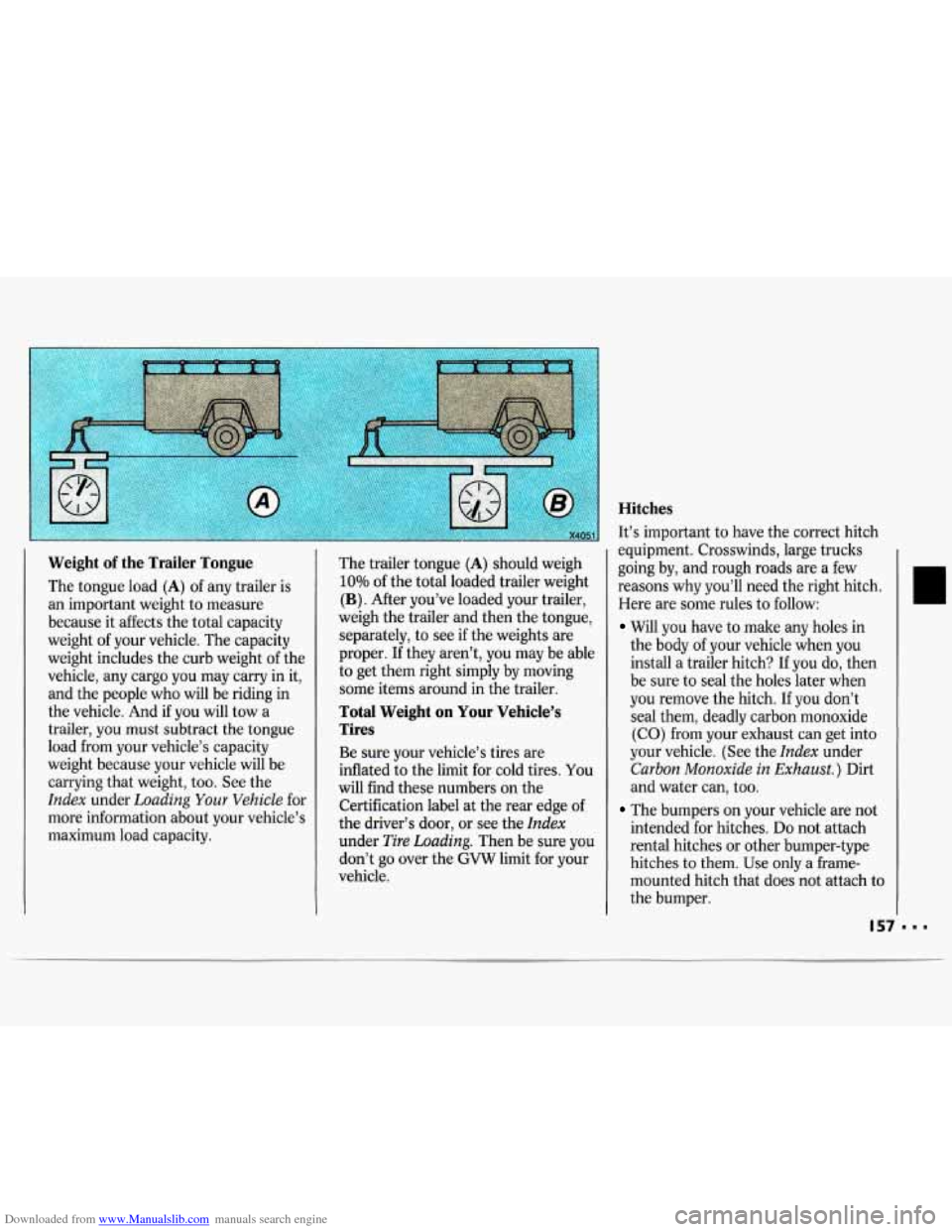
Downloaded from www.Manualslib.com manuals search engine Weight of the Trailer Tongue
The tongue load (A) of any trailer is
an important weight to measure
because it affects the total capacity
weight
of your vehicle. The capacity
weight includes the curb weight
of the
vehicle, any cargo you
may carry in it,
and the people who will be riding in
the vehicle. And
if you will tow a
trailer, you must subtract the tongue
load from your vehicle’s capacity
weight because your vehicle will be
carrying that weight, too. See the
Index under Loading Your Vehicle for
more information about your vehicle’s
maximum load capacity. The trailer tongue
(A) should
weigh
10% of the total loaded trailer weight
(B) . After you’ve loaded your trailer,
weigh the trailer and then the tongue,
separately, to see if the weights are
proper. If they aren’t, you may be able
to get them right simply by moving
some items around in the trailer.
Total Weight on Your Vehicle’s
Tires
Be sure your vehicle’s tires are
inflated to the limit for cold tires.
You
will find these numbers on the
Certification label at the rear edge of
the driver’s door, or see the
Index
under Tire Loading. Then be sure you
don’t
go over the GVW limit for your
vehicle.
Hitches
It’s important to have the correct hitch
equipment. Crosswinds, large trucks
going by, and rough roads are a few
reasons why you’ll need the right hitch.
Here are some rules to follow:
Will you have to make any holes in
the body
of your vehicle when you
install
a trailer hitch? If you do, then
be sure to seal the holes later when
you remove the hitch. If
you don’t
seal them, deadly carbon monoxide
(CO) from your exhaust can get into
your vehicle. (See the
Index under
Carbon Monoxide in Exhaust.) Dirt
and water can, too.
The bumpers on your vehicle are not
intended for hitches.
Do not attach
rental hitches or other bumper-type
hitches to them. Use only a frame-
mounted hitch that does not attach
to
the bumper.
Page 161 of 324
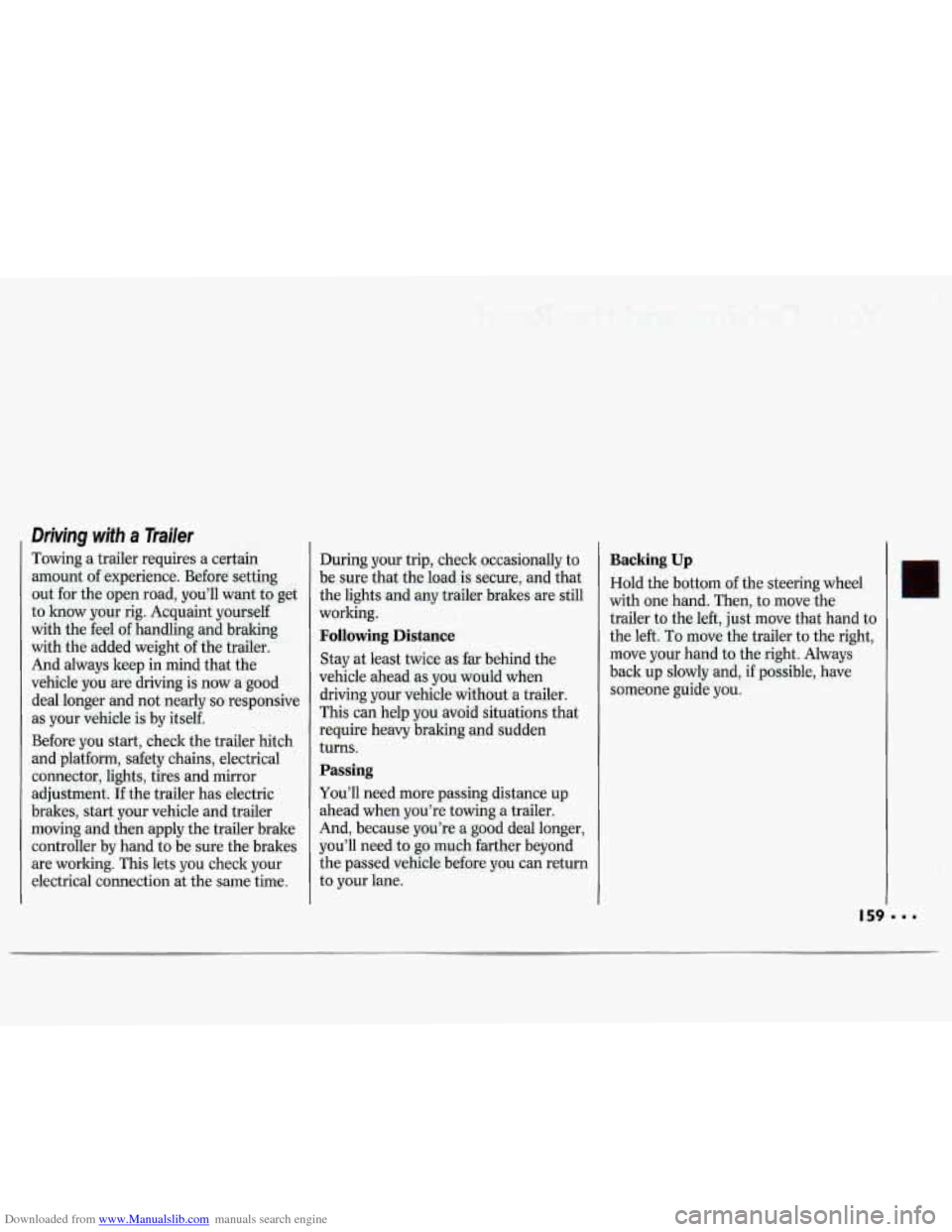
Downloaded from www.Manualslib.com manuals search engine Driving with a Trailer
Towing a trailer requires a certain
amount of experience. Before setting out for the open road, you’ll want to get
to know your rig. Acquaint yourself
with the feel of handling and braking
with the added weight of the trailer.
And always keep in mind that the
vehicle you are driving is now
a good
deal longer and not nearly
so responsive
as your vehicle is by itself.
Before you start, check the trailer hitch
and platform, safety chains, electrical connector, lights, tires and mirror
adjustment. If the trailer has electric
brakes, start your vehicle and trailer
moving and then apply the trailer brake
controller by hand to be sure the brakes
are worling. This lets you check your
electrical connection at the same time. During your
trip, check occasionally to
be sure that the load is secure, and that
the lights and any trailer brakes are still
working.
Following Distance
Stay at least twice as far behind the
vehicle ahead
as you would when
driving your vehicle without a trailer.
This can help you avoid situations that
require heavy braking and sudden
turns.
Passing
You’ll need more passing distance up
ahead when you’re towing a trailer.
And, because you’re a good deal longer,
you’ll need to go much farther beyond
the passed vehicle before you can return
to your lane.
Backing Up
Hold the bottom of the steering wheel
with one hand. Then, to move the
trailer to the left, just move that hand
to
the left. To move the trailer to the right,
move your hand to the right. Always
back up slowly and, if possible, have
someone guide you.
Page 226 of 324

Downloaded from www.Manualslib.com manuals search engine Service & Appearance Care
= = 224
Windshield Wiper Blade
Replacement
Replacement blades come in different
types and are removed in different
ways. Here’s how to remove the type
with a release clip:
1. Pull the windshield wiper ann away
2. Lift the release clip with a
from
the windshield.
screwdriver and pull the blade
assembly
off the wiper arm.
the wiper arm.
3. Push the new wiper blade securely on
Loading Your Vehicle
Two labels on your vehicle show how
much weight it may properly carry. The
Tire-Loading Information label found
on the inside of the trunk lid tells you
the proper size, speed rating and
recommended inflation pressures for
the tires on your vehicle. It also gives
you important information about the
number of people that can be in your
vehicle and the total weight that you
can carry. This weight is called the
Vehicle Capacity Weight and includes
the weight of all occupants, cargo, and
all nonfactory-installed options. The
other label is the Certification label,
on the rear edge
of the driver’s door. It
tells you the
gross weight capacity of
your vehicle, called the GVWR (Gross
Vehicle Weight Rating). The
GVWR
includes the weight of the vehicle, all
occupants, fuel and cargo. Never exceed
the GVWR for your vehicle, or the
Gross Axle Weight Rating
(GAWR) for
either the front or rear axle.
And,
if you do have a heavy load, you
should spread it out. Don’t carry more
than
167 lbs. (75 kg) in your trunk.
Page 227 of 324

Downloaded from www.Manualslib.com manuals search engine A
Do not load your vehicle any
Things you put inside your
heavier than the
GVWR or b vehicle can strike and iniure
the maximum front and rear
GAMS. If you do, parts on your
vehicle can break, or it can change
the way your vehicle handles. These
could cause you to lose control.
Also, overloading can shorten the
life of your vehicle.
‘I I
If you put things inside your vehicle-
like suitcases, tools, packages, or
anything else-they
will go as fast as
the vehicle goes. If you have
to stop or
turn quickly, or if there is a crash,
they’ll keep going. people
in a sudden
stop or turn, or
in a crash.
Put things in the trunk of your
vehicle. In a trunk, put them as
far forward
as you can. Try to
spread the weight evenly.
Never stack heavier things, like
suitcases, inside the vehicle
so
that some of them are above the
tops
of the seats.
When you wry something inside
the vehicle, secure it whenever
you can.
Don’t leave a seat folded down
unless
you need to.
. Tires
We don’t make tires. Your new vehicle
comes with high quality tires made by a
leading tire manufacturer. These tires
are warranted
by the tire manufacturers
and their warranties are delivered with
every new Chevrolet. If your spare tire
is a different brand than your road tires,
you will have a tire warranty folder from
each of these manufacturers.
A Poorly maintained and
dangerous.
I improperly used tires are
9 Overloading your tires can cause
overheating as a result of too
much friction. You could have an
air-out and a serious accident.
See Loading Your Vehicle earlier
in this section.
(Continued)
Page 319 of 324
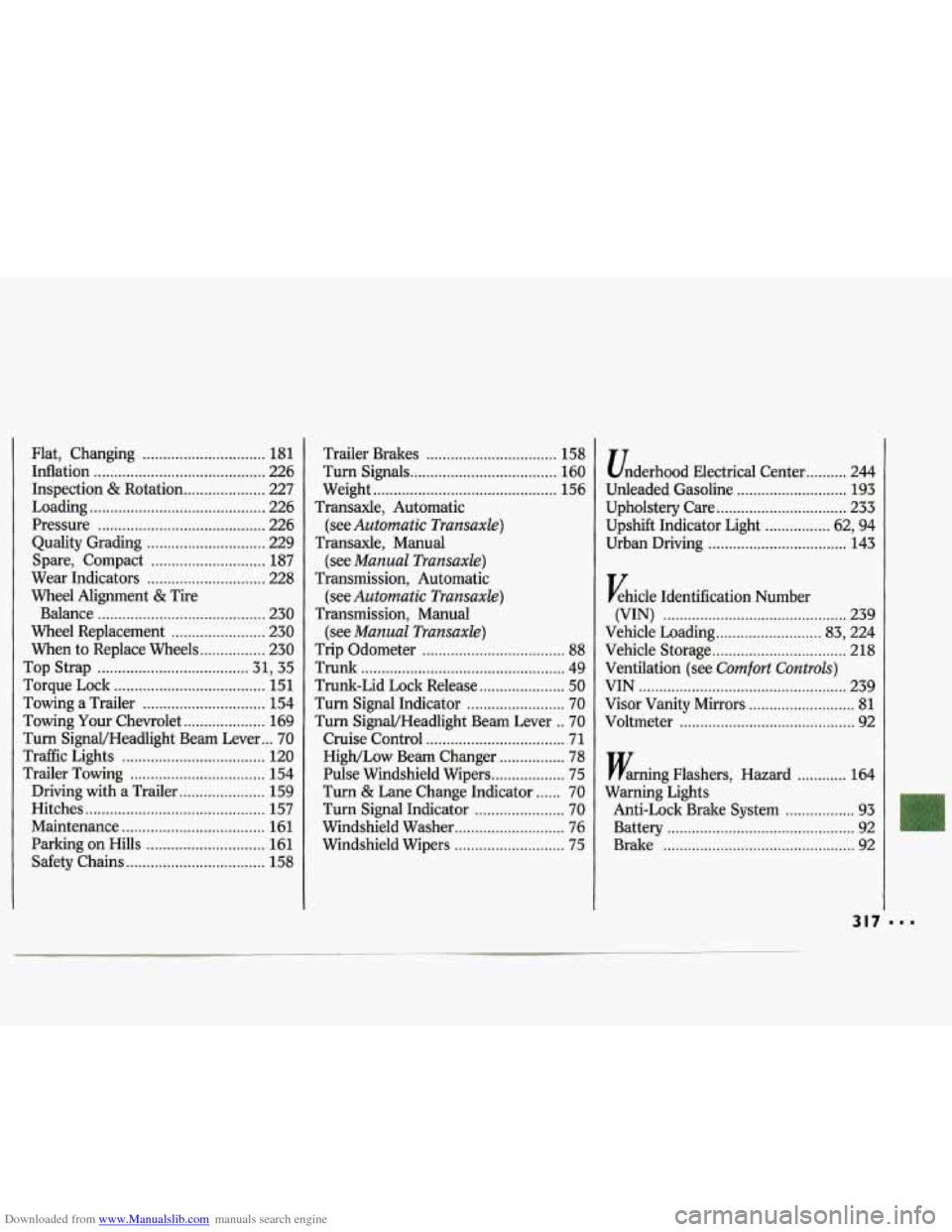
Downloaded from www.Manualslib.com manuals search engine Flat. Changing .............................. 181
Inflation .......................................... 226
Loading
........................................... 226
Pressure
......................................... 226
Quality Grading
............................. 229
Spare. Compact
............................ 187
Wear Indicators
............................. 228
Wheel Alignment
& Tire
Balance
......................................... 230
Wheel Replacement
....................... 230
Top Strap
..................................... 31. 35
Torque Lock
..................................... 151
Towing a Trailer .............................. 154
Towing Your Chevrolet
.................... 169
Turn SignaVHeadlight Beam Lever ... 70
Traffic Lights
................................... 120
Trailer Towing
................................. 154
Driving with a Trailer
..................... 159
Hitches
............................................ 157
Maintenance ................................... 161
Parking on Hills ............................. 161
Safety Chains .................................. 158
Inspection & Rotation .................... 227
When to Replace Wheels
................ 230 Trailer Brakes
................................ 158
Turn
Signals .................................... 160
Weight
............................................. 156
Transaxle. Automatic
(see
Automatic Transaxle)
Transaxle. Manual
(see
Manual Transaxle)
Transmission. Automatic
(see
Automatic Transaxle)
Transmission. Manual
(see
Manual Transaxle)
Trip Odometer ................................... 88
Trunk .................................................. 49
Trunk-Lid Lock Release
..................... 50
Turn Signal Indicator ........................ 70
Turn SignaVHeadlight Beam Lever .. 70
Cruise Control
.................................. 71
HigWLow Beam Changer ................ 78
Pulse Windshield Wipers .................. 75
Turn & Lane Change Indicator ...... 70
Turn Signal Indicator ...................... 70
Windshield Washer ........................... 76
Windshield Wipers ........................... 75
Underhood Electrical Center .......... 244
Unleaded Gasoline
........................... 193
Upholstery Care
................................ 233
Upshift Indicator Light
................ 62. 94
Urban Driving
................................... 143
Ehicle Identification Number
Vehicle Loading
.......................... 83, 224
Vehicle Storage
................................. 218
Ventilation (see
Comfort Controls)
VIN ................................................... 239
Visor Vanity Mirrors
.......................... 81
Voltmeter ........................................... 92
(VIN)
............................................. 239
Kning Flashers. Hazard
............ 164
WarningLights
Anti-Lock Brake System
................. 93
Battery
.............................................. 92
Brake
............................................... 92
317 ...
Page 320 of 324

Downloaded from www.Manualslib.com manuals search engine Index
Coolant Temperature ...................... 90
Low Coolant
.................................... 90
Oil
..................................................... 91
Service Engine Soon
........................ 94
Upshift Indicator
.............................. 94
Washer, Windshield
................... 76, 215
Weight Gross Axle Weight
Gross Vehicle Weight Rating (GAWR)
............................ 224
Rating (GVWR)
............................ 224
Wheel Alignment
& Tire Balance .... 230
Wheel Covers, How to Remove
..... 181
Wheel Nut Torque ................... 186, 248
Wheel Nuts
...................................... 183
Wheel Replacement .......................... 230
318
Windows
Power
............................................... 69
Standard
............................................ 69
Windshield Washer .................... .: ....... 76
Fluid
........................................ 76, 215
Windshield Wipers
.................... 75, 246
Cleaning
......................................... 236
Windshield Wiper Blade Replacement
........................ 224
Winter Driving
.................................. 151
If Your Car is Stuck in
Deep Snow
.................................. 154
If You’re Caught in a
Blizzard
........................................ 153
Wrecker Towing
.............................. 169